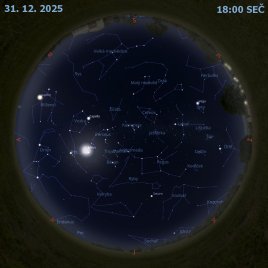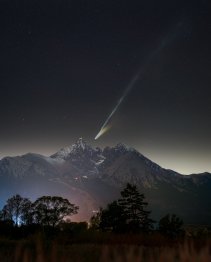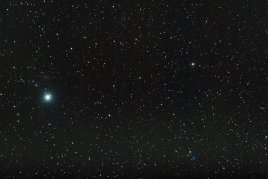Stěna vznikání hvězd v Labuti

Image Credit & Copyright: Johan Bogaerts
Mlhovina Severní Amerika na obloze umí to, co kontinent Severní Amerika na Zemi neumí, tvořit hvězdy. Přesněji řečeno, v analogii s pozemským kontinentem se jasná část jeví, jako Středí Amerika a Mexiko a je to ve skutečnosti ložiskem horkého plynu, prachu a nově vzniklých hvězd známé jako Stěna v Labuti. Na snímku je vidět hvězdotvorná stěna ozařovaná a erodovaná jasnými mladými hvězdami a částečně skrytými tmavým prachem, který samy vytvořily. Zobrazená část mlhoviny Severní Amerika (NGC 7000) zabírá asi 15 světelných roků a nachází se asi 1500 světelných roků daleko v souhvězdí Labutě (Cygnus).
Seznam odkazů v popisu
- Wikipedia: North_America_Nebula
- Wikipedia: North_America
- Wikipedia: Central_America
- Wikipedia: Mexico
- Panther-Observatory.com: The Great Wall and the Gulf (NGC 7000)
- Flickr.com: Johan Bogaerts: NGC7000 The Cygnus Wall
- APOD: 2020-12-06 M16: Pilíře stvoření hvězd
- APOD: 2021-11-24 Plejády: Hvězdokupa Kuřátka anebo Sedm sester
- Nvidia.co.kr: Foto: Kočička pod dekou :-)
- SWIN.edu.au: Dust Grain
- APOD: 2009-06-30 Mlhoviny Severní Amerika a Pelikán
- NASA: What Is a Light-Year?
- Wikipedia: Constellation
- HawAstSoc.org: Constellations: Cygnus -- Zeus on the Prowl, or a True Friend?
NASA Official: Phillip Newman Specific rights apply. NASA Web Privacy Policy and Important Notices
A service of: ASD at NASA / GSFC & Michigan Tech. U.
Odkaz na originální APOD


